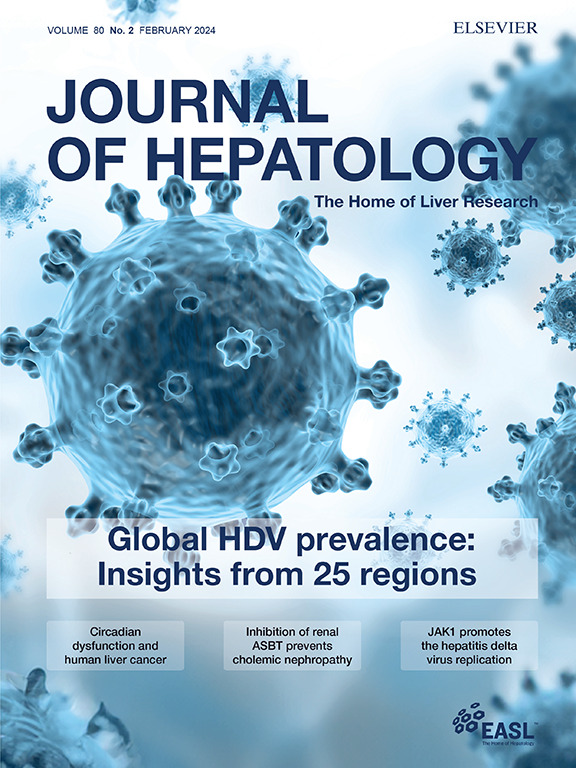Hepatic stellate cells regulate multiple aspects of hepatocyte function in health and disease
IF 33
1区 医学
Q1 GASTROENTEROLOGY & HEPATOLOGY
引用次数: 0
Abstract
Section snippets
Background and context
Hepatic stellate cells (HSCs) are best known as retinoid-containing cells in the space of Disse in healthy livers. In response to liver injury, they are activated, transdifferentiate into myofibroblasts and become the main scar-producing population in chronic liver disease (CLD). Much of the work on HSCs has focussed on their role in fibrogenesis, how they are activated and how they might be modulated or targeted to abrogate liver fibrosis.1,2 However, the key roles HSCs play in other aspectsObjectives, methods and findings
In a recent article by Sugimoto et al. in Nature, the authors aimed to better characterise the functions of HSCs in controlling hepatocyte behaviour during health and disease.5 They used Lrat-cre mice crossed with iDTR (inducible diphtheria toxin receptor) mice, facilitating selective depletion of Lrat+ HSCs in vivo following administration of low dose diphtheria toxin. HSC depletion in healthy mice resulted in reduced liver size with less hepatocyte proliferation, consistent with previousSignificance of findings
This work highlights the complex role of HSCs in regulating hepatocyte behaviour, with highly context- and injury-dependent functional consequences. The most striking finding was the profound role of HSCs in controlling hepatocyte metabolic zonation across the entire liver lobule. Whilst Wnt signalling is well known to regulate zonation of the liver6 and RSPO3 expressed by pericentral endothelial cells has previously been shown to be essential for zone 3 hepatocyte functions,7 the key role ofFinancial support
P.R. was funded by an MRC Senior Clinical Fellowship (MR/W015919/1).Conflict of interest
The author of this paper declares that they do not have any conflict of interest.Please refer to the accompanying ICMJE disclosure forms for further details.肝星状细胞在健康和疾病中调节肝细胞功能的多个方面
背景和背景肝星状细胞(hsc)被认为是健康肝脏组织间隙中含有类维甲酸的细胞。在肝损伤的反应中,它们被激活,转分化为肌成纤维细胞,并成为慢性肝病(CLD)中主要的瘢痕生成群体。关于造血干细胞的大部分工作都集中在它们在纤维化中的作用,它们是如何被激活的,以及它们如何被调节或靶向以消除肝纤维化。然而,造血干细胞在其他方面也发挥着关键作用。目的、方法和发现在Sugimoto等人最近发表在《自然》杂志上的一篇文章中,作者旨在更好地描述造血干细胞在健康和疾病期间控制肝细胞行为的功能他们使用Lrat-cre小鼠与iDTR(诱导白喉毒素受体)小鼠杂交,促进低剂量白喉毒素给药后体内Lrat+ hsc的选择性消耗。健康小鼠的HSC消耗导致肝脏大小减小,肝细胞增殖减少,与先前发现的意义一致。这项工作强调了HSC在调节肝细胞行为中的复杂作用,具有高度依赖环境和损伤的功能后果。最引人注目的发现是造血干细胞在整个肝小叶中控制肝细胞代谢带化的深刻作用。众所周知,Wnt信号可以调节肝脏的分区6,而中央周内皮细胞表达的RSPO3先前已被证明对3区肝细胞功能至关重要7,财政支持p.r的关键作用。由MRC高级临床奖学金(MR/W015919/1)资助。利益冲突本文作者声明他们没有任何利益冲突。详情请参阅随附的ICMJE披露表格。
本文章由计算机程序翻译,如有差异,请以英文原文为准。
求助全文
约1分钟内获得全文
求助全文
来源期刊

Journal of Hepatology
医学-胃肠肝病学
CiteScore
46.10
自引率
4.30%
发文量
2325
审稿时长
30 days
期刊介绍:
The Journal of Hepatology is the official publication of the European Association for the Study of the Liver (EASL). It is dedicated to presenting clinical and basic research in the field of hepatology through original papers, reviews, case reports, and letters to the Editor. The Journal is published in English and may consider supplements that pass an editorial review.
 求助内容:
求助内容: 应助结果提醒方式:
应助结果提醒方式:


